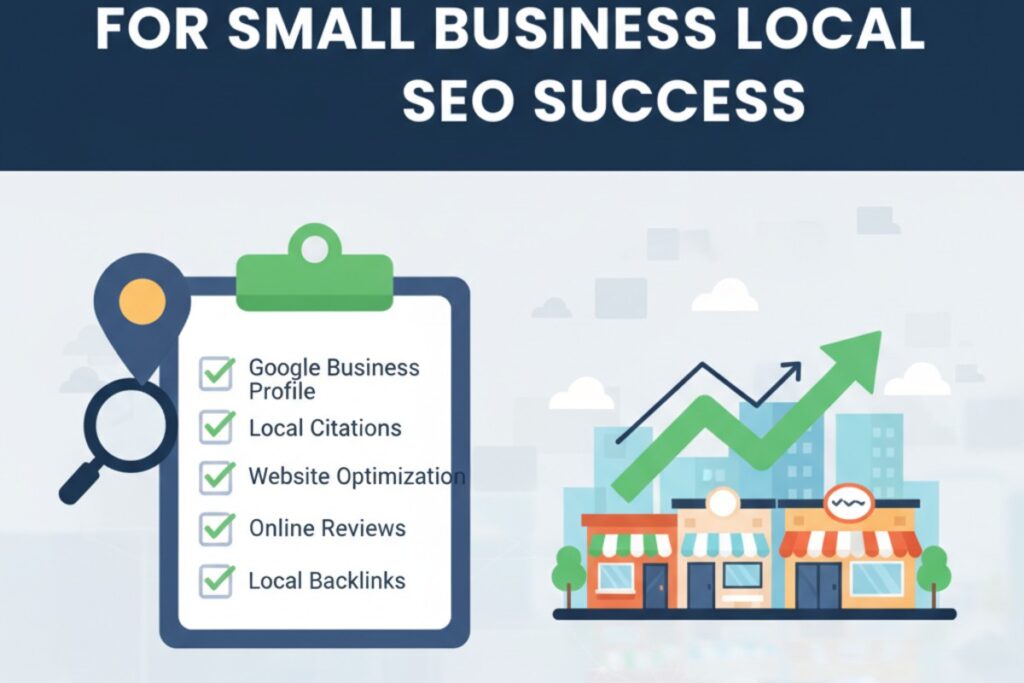Local search engine optimization is one of the most effective ways for small businesses to attract nearby customers. When someone searches for a product or service in their area, Google and other search engines display results based on location and relevance. Businesses that invest in a structured local SEO strategy gain higher visibility, more traffic, and increased sales. The following checklist outlines the most important steps to achieve consistent local SEO success.
1. Google Business Profile Optimization
An optimized Google my Business Profile is important. Add accurate business information, including name, address, and phone number. Choose the correct primary category and relevant secondary categories. Write a clear business description using natural language that reflects your services and location. Upload current photos of your storefront, staff, and products. Set regular and holiday hours and update them when needed. Encourage customers to leave reviews and reply to every review with professionalism.
2. Consistent NAP Information
Search engines verify business legitimacy through consistency. Your business name, address, and phone number must match across every online listing. Review directories, social profiles, and citations. Correct any variations or outdated information. Uniformity helps search engines connect your listings to one verified entity and supports stronger ranking signals in local results.
3. Local Keyword Research
Effective keyword research is the foundation of any successful local SEO strategy. Identify search terms that combine your services with geographic modifiers. Focus on keywords that customers are likely to use when looking for nearby businesses. Research search volume, competition, and relevance. Integrate these keywords naturally into website pages, meta tags, and headings. Each page should target a unique keyword related to your business and location.
4. On-Page Optimization
Every page on your website should support your local SEO goals. Optimize title tags, meta descriptions, and headers with local keywords. Maintain a logical URL structure that describes the content clearly. Use images with descriptive file names and alt text. Add internal links to connect related pages and improve crawlability. Ensure each page has enough text content to explain your services and answer customer questions. A properly optimized site helps search engines understand your location, relevance, and authority.
5. Locally Focused Content
Content tailored to your local audience strengthens your local presence. Create pages for each service area and include information about nearby landmarks or neighborhoods. Write blog posts that discuss local events, industry news, or community involvement. Feature customer stories or local partnerships that demonstrate credibility. Consistent content updates show search engines that your business is active and engaged with its community.
6. Building Local Backlinks
Backlinks from reputable local sources improve authority and visibility. Reach out to nearby organizations, newspapers, and business associations for link opportunities. Sponsor community events or collaborate with other local businesses. Submit your website to trusted local directories. Quality local backlinks signal to search engines that your business is relevant to a specific area, helping improve rankings for geographic searches.

7. Mobile Optimization
A large percentage of local searches happen on mobile devices. Your website or app must perform well on smartphones and tablets. Use responsive design to ensure the layout adapts to different screens. Keep navigation simple and make phone numbers clickable. Ensure pages load quickly to prevent users from leaving. A mobile-friendly site enhances user experience and directly influences search performance.
8. Review Management
Online reviews are still one of the strongest local SEO ranking factors now-a-days. Encourage satisfied customers to leave feedback on Google and other review sites. Provide clear instructions or direct links to simplify the process. Respond to all reviews promptly and courteously. Positive engagement shows customers that their opinions matter and builds trust. Negative feedback should be addressed constructively to demonstrate accountability and commitment to service.
9. Local Schema Markup
Schema markup provides structured data that helps search engines interpret your business details. Implement local business schema on your website, including information such as name, address, phone number, opening hours, and service areas. This data can enhance your search result listings by adding features like ratings and business hours, improving click-through rates and user confidence.
10. Tracking and Analytics
Monitoring performance ensures your efforts produce measurable results. Use Google Analytics to track website traffic and user interactions. Review Google Search Console for search queries, impressions, and click data. Analyze Google Business Profile Insights to understand how customers find your business. Measure metrics such as keyword rankings, phone calls, and direction requests. Regular analysis helps identify trends and refine your local SEO strategy over time.
11. Social Media Integration
Social platforms contribute to brand visibility and local engagement. Maintain consistent business information across all social channels. Share local content and encourage interaction with followers. While social signals are not direct ranking factors, they increase online presence and can generate valuable referral traffic to your site.
12. Technical SEO Foundation
A solid technical setup supports all other SEO activities. Use HTTPS for site security. Create an XML sitemap and submit it to search engines. Fix broken links and eliminate duplicate content. Ensure clean site architecture with simple navigation. Implement structured internal links to distribute authority evenly across pages. A technically sound website ensures that search engines can crawl and index your pages efficiently.
13. Citations and Directory Listings
Local citations reinforce your legitimacy and help search engines verify your information. Submit your business to reputable online directories and niche platforms related to your industry. Focus on quality rather than quantity. Each listing should contain identical business information and a link to your website. Periodically check for errors or outdated details to maintain accuracy.
14. Continuous Improvement
Local SEO is an ongoing process that requires regular review and updates. Search algorithms evolve, competitors adjust their strategies, and user behavior changes. Periodically revisit your keyword research, website content, and backlink profile. Maintain consistent engagement with customers through reviews and social media. Continuous effort ensures sustainable local SEO success and steady business growth.
Conclusion
A well-executed local SEO strategy enables small businesses to compete effectively within their communities. By following this checklist—covering Google Business optimization, NAP consistency, keyword targeting, content creation, backlink building, and ongoing analysis—your business can achieve lasting visibility in local search results. Consistent execution of these principles ensures stronger customer connections, higher search rankings, and long-term growth in both online and offline markets.

